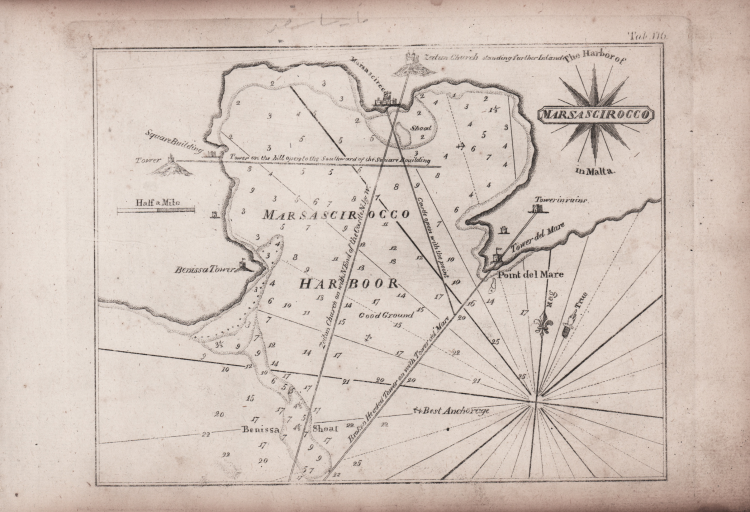



| Reference: | CO-604 |
| Author | William Heather |
| Year: | 1802 |
| Zone: | Marsaxlokk |
| Printed: | London |
| Measures: | 200 x 155 mm |


| Reference: | CO-604 |
| Author | William Heather |
| Year: | 1802 |
| Zone: | Marsaxlokk |
| Printed: | London |
| Measures: | 200 x 155 mm |
Rare antique engraved chart of Marsaxlokk, on the southern tip of Malta, published by William Heather in London. The chart is oriented with north at the top. It includes soundings, some topographical features and anchorages. Towers, churches, and ruins are given as landmarks for taking one's bearings in the harbor.
The charts from Heather's New Mediterranean Pilot . . . are extremely rare on the market. This small chart comes from the first English attempt at a collection of ports of the Mediterranean, although the genre was well established in France, Italy, and Spain already. The first was published by Joseph Roux in Marseilles in 1764, with versions published in several Italian port cities. The French and Italian versions were of relatively crude execution, but Heather’s version is notable for the finely engraved charts, many signed in monogram by the London engraver John Stephenson.
William Heather (1764–1812) started business in 1793, as a publisher and dealer in charts and nautical instruments. He had learnt is trade from the chart publisher and teacher of navigation John Hamilton Moore, with whom he resided for five years. Heather’s premises were based on the same street as the East India Company, at 157 Leadenhall Street, under the sign of the ‘Little Midshipman’, later known as the ‘Navigation Warehouse’. In 1796, he joined in partnership with his neighbour, book and printseller, Thomas Williams, with the business being known as ‘Heather and Williams’, or Heather & Co.; the partnership would last until 1800. During this time John Norie – another pupil of John Hamilton Moore – joined the firm, as a draftsman of charts and teacher of navigation. Norie would later take over the business following Heather’s death in 1812, and turn it into the leading independent chart publisher’s of the nineteenth century. The business would later be immortalised by Charles Dickens, in Dombey & Sons.
|
William Heather (1764–1812) started business in 1793, as a publisher and dealer in charts and nautical instruments. He had learnt is trade from the chart publisher and teacher of navigation John Hamilton Moore, with whom he resided for five years. Heather’s premises were based on the same street as the East India Company, at 157 Leadenhall Street, under the sign of the ‘Little Midshipman’, later known as the ‘Navigation Warehouse’. In 1796, he joined in partnership with his neighbour, book and printseller, Thomas Williams, with the business being known as ‘Heather and Williams’, or Heather & Co.; the partnership would last until 1800. During this time John Norie – another pupil of John Hamilton Moore – joined the firm, as a draftsman of charts and teacher of navigation. Norie would later take over the business following Heather’s death in 1812, and turn it into the leading independent chart publisher’s of the nineteenth century. The business would later be immortalised by Charles Dickens, in Dombey & Sons.
|
|
William Heather (1764–1812) started business in 1793, as a publisher and dealer in charts and nautical instruments. He had learnt is trade from the chart publisher and teacher of navigation John Hamilton Moore, with whom he resided for five years. Heather’s premises were based on the same street as the East India Company, at 157 Leadenhall Street, under the sign of the ‘Little Midshipman’, later known as the ‘Navigation Warehouse’. In 1796, he joined in partnership with his neighbour, book and printseller, Thomas Williams, with the business being known as ‘Heather and Williams’, or Heather & Co.; the partnership would last until 1800. During this time John Norie – another pupil of John Hamilton Moore – joined the firm, as a draftsman of charts and teacher of navigation. Norie would later take over the business following Heather’s death in 1812, and turn it into the leading independent chart publisher’s of the nineteenth century. The business would later be immortalised by Charles Dickens, in Dombey & Sons.
|